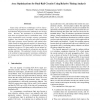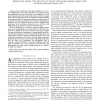57 search results - page 6 / 12 » Timing metrics for physical design of deep submicron technol... |
ASYNC
2007
IEEE
14 years 1 months ago
2007
IEEE
Future deep sub-micron technologies will be characterized by large parametric variations, which could make asynchronous design an attractive solution for use on large scale. Howev...
SBCCI
2003
ACM
14 years 18 days ago
2003
ACM
As we scale down to deep submicron (DSM) technology, noise is becoming a metric of equal importance as power, speed, and area. Smaller feature sizes, low voltage, and high frequen...
ICCAD
2006
IEEE
14 years 4 months ago
2006
IEEE
With the advent of deep sub-micron (DSM) era, floorplanning has become increasingly important in physical design process. In this paper we clarify a misunderstanding in using Lag...
ICCAD
2000
IEEE
13 years 11 months ago
2000
IEEE
Abstract— Deep submicron technology scaling has two major ramifications on the design process. First, reduced feature size significantly increases wire delay, thus resulting in...
ICCAD
2003
IEEE
14 years 4 months ago
2003
IEEE
Ultra-deep submicron manufacturability impacts physical design (PD) through complex layout rules and large guardbands for process variability; this creates new requirements for ne...


